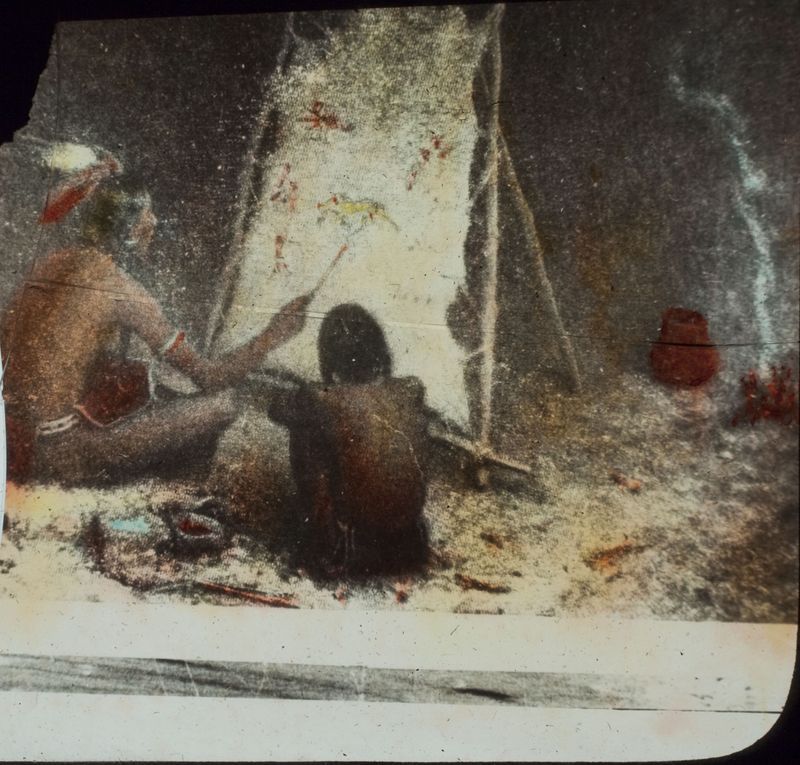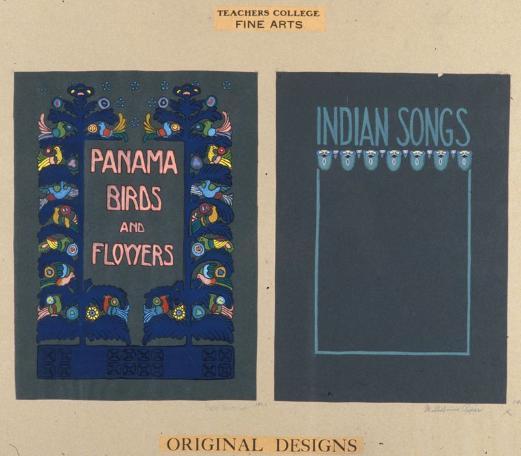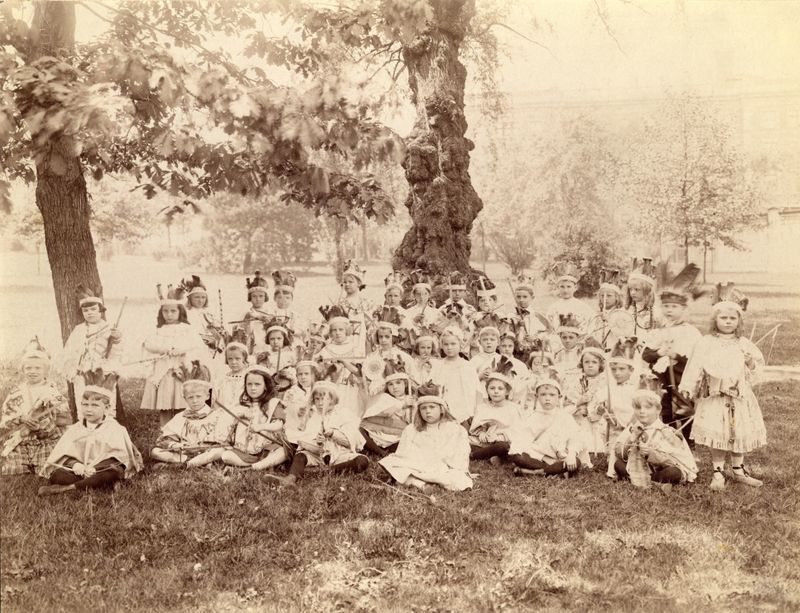Archival Exercises: Examining Marginalized Histories

“The forgetting of the history of marginalized groups is both a cause and effect of their marginalization.”
-- Susan Jacoby
This guide presents select archival resources for students in the class, Histories of Art Education, A&HA 4085 001, taught by Dr. Ami Kantawala, with a focus on archival research of marginalized or international individuals and peoples. Exercises include exploration of relevant historical text, images, and objects from the Gottesman Libraries.
Select Resources:
Bolin, Paul E., Ami. Kantawala, and Mary Ann. Stankiewicz. Steppingstones : Pivotal Moments in Art Education History. New York, NY: Teachers College Press, 2021. e-book
"Representing the first extensive volume on the history of art education to be published in 20 years, this book will generate new interpretations of both local and global histories for 21st-century readers. Steppingstones captures pivotal moments in art education history within the United States and globally. Chapters are situated within the broad and active stream of history, identified by the authors as places to pause, step down, and deeply explore these moments and the vibrant terrain that surrounds them. Some steppingstones in the volume are new and fresh reappraisals of familiar and well-recognized landing places in art education history. Other steppingstones contain discussions of previously unknown or overlooked material uncovered by the authors. Digging deep, getting beneath, and revealing steppingstones that embrace a pathway through the past, this book explores dynamic and spirited narratives about various people, institutions, events, tensions, and international perspectives that have shaped and continue to direct the course of art and design education. Book Features: Investigates contemporary issues through a lens toward the past, including issues of race, cultural protocols, intersectionality, international influence, White privilege, disability studies, and other social concerns. Presents contributions from well-known senior scholars alongside new voices of several emerging scholars of color. Includes biographical accounts of African American artists and educators, and the role and influence of the Harlem Renaissance. Contains discussion of art education in colonial India and explores complex relationships between colonizer-colonized histories. Focuses on art education in the United States with discussion of specific international influences. Offers contemporary best practices for doing historical research and strategies for teaching art education history courses at the university level. Highlights the significance of digital humanities and digital scholarship."
Lewis, Kathleen Phillips. How to Research Marginalized Groups
This guide introduces "students to the special considerations, appropriate methods, and best practices for researching marginalized groups. The guide will address matters of definition –how is marginality defined and what are its identifiable features, how do groups come to be marginalized, how to determine whether or not a group meets the criteria to be classified as marginalized and in what way/s, how can marginal status change over time. It will include marginality as a result of caste, social or economic class, language, political subjugation, conquest, colonialism, and imperialism, national origin, regional location, disability, medical condition, race, ethnicity, age, religion, cultural norms, belief and value structure, legal classification, immigrant status, sex and gender identification, sexual orientation. The guide will provide clues on how to locate relevant sources, check their validity, and conduct thorough, critical interrogation and balanced interpretation of those sources. The guide will also outline problems that can arise in the course of researching marginalized groups, for example a paucity of sources, gaps and silences therein, identifying biases and nuances in meaning that are contextually referenced by geopolitical, linguistic, cultural, historical, and other parameters. Drawing from several examples of various historically marginalized groups, it will illustrate how best to find, probe and interpret different types of primary sources, avoid pitfalls inherent in their use, select appropriate research methodology and theoretical framework, determine when a group can be classified as marginalized, interrogate factors that create or impact their lived experience of marginalization, and draw sound conclusions."
Research Methods in Primary Sources, by Adam Matthew Digital, 2021-
This "is an online learning tool for primary source literacy that can be used in classroom-based and online teaching, as well as for independent study; it contains nearly 200 hundred essays, videos, 'How to' guides and case studies by subject specialists which answer all of your questions about working with primary sources. From guidance on where you can find historical documents, to the questions you might want to pose and how best to approach analyzing the content they hold, this platform gathers together practical advice and instruction from experts working around the world."
 "
"
The idea that heterogeneous people could be made alike through the proper kind of education lay at the heart of the common school ideal of nineteenth-century reformers like Horace Mann. It shaped the crusade to assimilate American Indians to 'civilized' ways. It persisted in the campaign to Americanize the children of immigrants during the Progressive Era. In the 1950s it undergirded the ideology of educators who sought to be race-blind, gender-blind, and class-blind. It inspired those in the 1960s who believed that compensatory instruction could overcome the handicaps imposed by poverty. And it underlay the faith of those integrationists who believed that blacks and whites differed chiefly in the color of their skins.
Policymakers who believed in the potential similarity of all people shared an optimistic and often generous faith--and tunnel vision. Confident in their own values, they failed to understand diverse cultures or to explain their persistence. Assimilation was only partial at best: Indians remained Indians, ethnic loyalties and cultures did not disappear, race continued to divide society, and the poor remained at a severe disadvantage. Fortunately, diversity did not--could not--disappear at the wave of a pedagogical wand. Instead, cultures of all Americans have evolved through reciprocal relationships."
--David B. Tyack, Constructing Difference: Historical Reflections on Schooling and Social Diversity (Teachers College Record, Volume 95, Number 1, 1993, p. 8-34)
Tools
- Archive Grid, a network of archival collections held by libraries, historical societies, museums, and archives
- Archives of American Art - Smithsonian Institution - the largest collection of primary resources documenting the history of the visual arts in the United States. More than 20 million items of original material are housed in the Archives' research centers in Washington, D.C. and New York City.
- National Archives - Produced by the National Archives and Records Administration (NARA), an independent agency of the United States government, which is officially responsible for maintaining and publishing the legally authentic and authoritative copies of acts of Congress, presidential proclamations and executive orders, federal regulations, and a wealth of other historical documents and records.
- New York Public Library Digital Collections, contains 901,739 items digitized from The New York Public Library's collections, and described as "a living database with new materials added every day, featuring prints, photographs, maps, manuscripts, streaming video, and more"
- Pocketknowledge, the digital archive of Teachers College, Columbia University which contain rare and original items, many of which can be found only at Teachers College. The scope includes: primary sources, dissertations, and media from some of the most influential figures in education, psychology, and health.
- Proquest Historical Newspapers provides Full-text and full-image articles from major American newspapers: Atlanta Constitution, Baltimore Sun (1837-1985), Boston Globe, Call and Post (1934-1991), Chicago Tribune, Christian Science Monitor (1908-1997), Irish Times (1859-2009), Los Angeles Times, New York Times, Norfolk Journal and Guide (1921-2003), Philadelphia Tribune (1912-2001), San Francisco Chronicle (1865-1922), Wall Street Journal, Washington Post, Scotsman (1817-1950) every page in PDF files.
Locating Physical Archives
There are several ways to locate primary resources that may be of interest to you. These include searching online catalogs, national or institutional archival databases, or inquiring directly at individual institutions. Any institution could potentially have an archive, from a small theater to governmental agencies or corporations. If you have an interest in a particular institution, you should contact that institution directly to inquire if they have an archive and whether you may access it. Here is a very small selection of some of New York City's largest institutions with physical archives:
- Finding Aids Portal for New York University's Fales Library & Special Collections
- New York City Board of Education Records, 1842-2002 - Records of the Board of Education, from its creation in 1842 to its replacement by a mayoral Department of Education in 2002. Also included are records of the Board of Education of the City of Brooklyn from 1853 to 1897. These records document aspects of educational policy-making and school-system administration. Located at the New York City Municipal Archives. See here for the Digital Gallery of New York City Board of Education photos.
If you are curious to see where else in the world collections on an individual or group may be held, you can search WorldCat (short for "world catalog"). To do this, use the advanced search, select "archival material" as the format, and search by keyword. Once you locate a collection of interest, you can inquire at the individual institution to get access.
Using a Finding Aid
Finding aids are the documents created by archivists to describe and give context to collections and help users identify what parts of the collection are of interest to them. They usually consist of the following sections, which may vary in title:
- Title and years of coverage: The title is usually the name of the person who collected the documents. While the collection will be most closely related to this person, it may hold contents of interest on other individuals. Be sure the years match those you are interested in.
- Overview: provides the size of the collection (usually in linear feet or number of boxes), its creator, and a brief abstract.
- Administrative information: details guidelines for citation and any access restrictions.
- Historical or biographical note: summarizes the life of an individual or the history of an institution and can serve as a starting point for further biographical research.
- Scope and content note: describes the content of the collection including topics, types of materials, and years covered.
- Arrangement: lists the hierarchical order of the collection as it has been arranged in the archive.
- Box and folder list: details the box and/or folder numbers of the collection and their contents.
Knowing these essential parts of a finding aid can help you decide if a collection is relevant and which boxes or folders to request when onsite. It is important to note that access policies vary by institution and /or by collection, so you should make sure you are able to access a collection before visiting the institution.

"Pupils often seem surprised to find that learning is not just one process, but that it is composed of many processes. Quizzed about how to study one will often answer, 'Oh, I read it over and over.' Are pupils aware that reading is not 'just reading'? Do they skim to locate material or does the matter in hand require study—that kind of reading which turns over every phrase for its utmost meaning? Or is this material something that requires no more than unbroken recreational reading? It is not a history assignment when a pupil is interested to know what the Indians of America called themselves before the explorers called them Indians. If one has not a 'skimming' technique perfected by practice one wastes much time in trying to find the answer in the sources common to the usual school library. The librarian may start one on the road, saying, 'Probably the answer is in this; but you will have to skim a lot to find it.'"
-- A Library in Action in a Modern School, by Grace L. Aldrich & Cecile White Flemming (Teachers College Record, Volume 38, Number 5, 1937, p. 389-404)
Discussion Prompts
Manuscripts
Examine the master's thesis by artist educator Alma Thomas. Theses 0 1935 v.26 (digital version)
- Why do you think Thomas wrote it on "The Marionette Show as a Correlating Activity in the Public Schools”? Also see Walz, Jonathan Frederick, "Alma W. Thomas: 'The Marionette Show as a Correlating Activity in the Public Schools.'” (2019). Living Objects: African American Puppetry Essays. 17.
Compare the resources below. Does Mather's sermon relate in any way to his theories on education or the marginalization of women in colonial Massachusetts? What conclusions do you draw from his sermon?
- Sermon 1719, by Cotton Mather. MG 40 (MS 70).
- Mather, Cotton, and Ezekiel Cheever. Corderius Americanus A Discourse on the Good Education of Children, &c. &c. Delivered at the Funeral of Ezekiel Cheever, Principal of the Latin School in Boston; Who Died, August, 1708, in the Ninety-Fourth Year of His Age. With an Elegy and an Epitaph. Boston: Dutton & Wentworth, 1828.
- Mather, Cotton, and Increase Mather. The Wonders of the Invisible World. : Being an Account of the Tryals of Several Witches Lately Executed in New England. To Which Is Added, A Farther Account of the Tryals of the New-England Witches. London: J.R. Smith, 1862.
Review a small selection of documents from the the papers of Hazel Hertzberg, an authority on Native American Education.
- Assess how they illuminate Hertzberg's thinking on Pan-Indianism, an approach to promoting unity and cultural homogenization.
Letters
Study the Lowenfeld-D'Amico Correspondences on Aptitude Tests.
- Is there a relationship between intelligence testing and race, ethnicity, and/or gender in art education and industrial education? Is there any connection between African Americans and art?
Art (Visuals, Objects)
Select two pieces from the Ukrainian Children's Art Collection and place them in historical context, using an historical photograph from the Ukrainian Education Photograph Collection.
- Describe the pieces and what they reveal about Ukrainian history and Soviet Education.
Explore Native American motifs in the Students of Arthur Wesley Dow Collection (framed piece).
- How well do these pieces address Elements of Composition, and why do you think this motif was chosen as an artistic exercise?
Look at Railroad Train Arriving at Ranger, Texas. From the Rothman Lantern Slide Collection.
- Describe how this slide could have been used in the classroom; what does it reveal about the social studies curriculum? Find lantern slides of a similar theme.
Curricula
Examine: Feng, Zikai, and Zhaowen Wang. From Feng Tse-Kai’s Drawings of Children. Peking: Foreign Languages Press, 1956. Curr NC1235.F4 W3 1956
- What do Feng Tse-Kai's drawings tell us about marginalization or oppressed peoples in China, 1920's-1950's?
See Lederer, Charlotte. Made in Hungary, With 70 Colored Pictures and 160 Full Page Photographs. Budapest, Hungary: Dr. George Vajna & Co. Publishers, 1933. Curr NK944 . H9 L4 1933
"When the Magyars conquered Hungary, the Slave, Kun and Bessenyo nations which inhabited it, were subdued to slavery and used for fieldwork and other hard labor."
- Where does "Hungarian peasant art" come from? How might changes in government be reflected in changes in curriculum?
Compare the 12 color plates by William Dickes in Household Pictures for Home and School. (London: Jarrold & Sons, 1869). Curr NE1870 .H6 1869 (formerly W D558)
- How do the plates depict marginalized populations in Victorian London? Describe how these plates serve an educational purpose.
Images:
N.A. Indians, Plains, Picture Writing, The Rothman Lantern Slide Collection, Courtesy of Teachers College, Columbia University
Panama Birds And Flowers, Indian Songs, Students of Arthur Wesley Dow Collection, Courtesy of Teachers College, Columbia University
Horace Mann School. Children Of The First Grade Dressed As Indians. Outdoors. Teachers College. (1906), Historical Photographs of Teachers College, Courtesy of Teachers College, Columbia University


